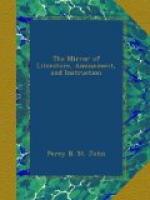[5] For an interesting account
of the founding and a view of
this abbey, see the MIRROR
for Sept. 30, 1826.
[6] Eastmead’s “Historia Rievallensis.”
* * * * *
ON VIEWING THE RUINS OF BYLAND ABBEY THROUGH THE DETACHED GATEWAY ON THE WEST.
Oh! beauteous picture! thou art ruin’s
theme,
And envious time the Gothic
canvass sears.
Thy soft decay now almost
wakes my tears,
And art thou mutable? or do I dream?
The transept moulders to its mound again;
The fluted window buries in
its fall
The rainbow flooring of the
fretted hall;
And long the altar on that earth has lain.
Now could I weep to see each mourning
weed
So deeply dark around thy
wasting brow;
If life and art are then so
brief—I bow
With less of sorrow to what is decreed:
Ye faded cloisters—ye
departing aisles!
Your day is past, and dim
your glory smiles!
Four miles from Byland is Coxwold, once the residence of the celebrated Laurence Sterne, author of Tristram Shandy, &c. It is a beautiful and romantic retreat, excelling the “laughing vine-clad hills of France,” which attracted the spirit of our English Rabelais to luxuriate amidst them. Here we gained admittance to the little church, an interesting edifice, noted for its sumptuous monuments to commemorate the Fauconbridge and Belasyse families, and for its being the scene of Sterne’s curacy. A small barrel organ now graces its gallery, which responded to the morning and evening service in Yorick’s day. On prying about the belfry we discovered an old helmet, with the gilding on it still discernible, which we at first supposed to be intended as a decoration to some tomb; but its weight and size precluded that supposition. In the church of Coxwold, the moralist might amass tomes of knowledge, and acquire the most forcible conviction of the fleeting nature of earth and its possessors. On glancing around he would perceive the heraldic honours of a most noble and ancient family now extinct—the paltry remains of the splendid helmet, which had decked, perhaps, the proud hero of feudal power, thrown into a degrading




